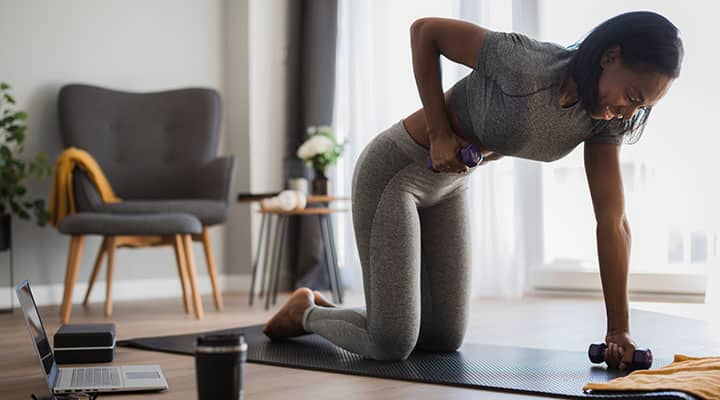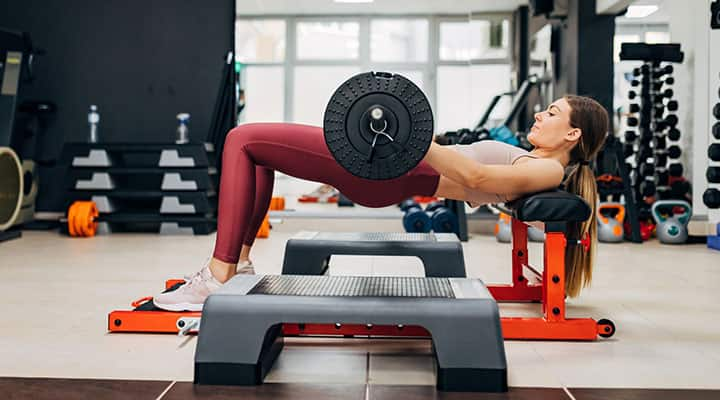
10 Lower Back Exercises for Strength and Recovery
Published: March 2025
Have you ever bent down to tie your shoes only to feel discomfort in your lower back?
Babying your lower back is no fun, but these undesirable moments don't mean you're destined for a life of limitations.
You just need to work on your muscle strength a bit, which isn't as daunting as it might sound. With the right exercises to strengthen and stretch your lower back muscles and improve spinal flexibility, you'll be stronger before you know it!
Why does my lower back get so tight sometimes?
There are many reasons people experience occasional back discomfort or stiffness—too many to list. But let's look at it from an anatomical viewpoint.
The lower back, also known as the lumbar spine, is composed of just five vertebrae. These five vertebrae support most of your body weight. Plus, the lumbar spine serves as an attachment point for many muscles and ligaments.
The muscles of your lower back, along with the flexibility of your vertebrae, allow your trunk to move in all planes of motion. In other words, your lower back has some big responsibilities. If you had that much on your plate, you'd get a little uptight, too, sometimes.
That said, there are certain factors that can affect lower back discomfort. These include your:
Age
—Unfortunately, occasional discomfort in the lower back is more common after the age of 45.Stress levels
—It's true: you carry stress in your body, and some of it may be camping out in your lower back.Job
—Certain job-related activities can add physical stress to your back, such as heavy lifting, pushing, pulling or twisting. On the other hand, poor posture while sitting at a desk all day can also contribute to muscle stiffness.Body weight
—Carrying even a few extra pounds can mean lower back discomfort.Physical activity
—If you're not in an exercise or stretch routine, your lower back and core muscles may be weaker than ideal. On the other hand, overtraining or starting intense exercises after a long period of inactivity can put you at risk of occasional lower back discomfort.
Exercise routine to strengthen your lower back
While you may not be able to control your age or your job, there is plenty you can do to improve or relieve your back. The following exercises can help strengthen and stretch your lower back muscles, so you can maintain an active lifestyle—both inside and outside the gym.
1. Deadlifts
Deadlifts are one of the best exercises you can do. Not only do they work the glutes, hamstrings, erector spinae, trapezius, hip adductors and core muscles, but as the National Strength and Conditioning Association (NSCA) explains, because it requires the entire body to be engaged for proper completion, few exercises activate your lower muscles like the deadlift.
Deadlifts place significant stress on the musculoskeletal system, which leads to strength development, as well as positive changes in bone density, muscle mass, resting metabolic rate and lower back discomfort—making it a staple for better performance and overall physical health.
Start with your feet hip-distance apart and a barbell resting on the floor in front of your ankles. Initiate a hip hinge by shifting your hips backward, letting your upper body naturally fall forward. After grabbing the barbell, pull your shoulders down and back to activate your upper back muscles. As you feel the stretch in your hamstrings and lower back, shift your hips forward until fully extended to complete the rep. Keep your chin slightly tilted up, feet firmly planted on the ground and knees pushed out to maintain proper alignment.
Pro tip: The sumo deadlift may be a better variation if you're prone to lower back discomfort because it engages more glutes and fewer lower back muscles. Simply plant your feet wider than hip distance and turn your toes out, so you're in a wide 'V' stance.
2. Hyperextensions
Hyperextensions are one of the best exercises for targeting the erector spinae, which is the group of low back muscles responsible for stabilizing the spine. They also support the hamstrings, glutes and core.
Lie face down on the floor or on a hyperextension bench. With straight legs, squeeze your glutes and lift your upper body off the ground or up from the bench. Pause with glutes, hamstrings and back muscles engaged before lowering back down.
3. Bird dog low row
The muscles worked in the bird dog low row are largely responsible for helping you stay upright and maintain good posture. Good posture, of course, helps relieve occasional discomfort in the lower back. Also, compound exercises like the bird dog low row train your body to utilize multiple muscle groups at one time—similar to your normal, everyday movement—and teach you to do daily activities safer and more efficiently.
Start in a tabletop position with your hands and knees on the floor. Keep your hands stacked directly under your shoulders and knees stacked directly under your hips. Kick your right leg straight back behind you and squeeze your glutes to hold it up. Grab a dumbbell with your left hand. Maintaining a neutral grip (palm facing in), pull the dumbbell back toward your left hip. Lower the left arm to reset.
4. Dead bug
The dead bug is an isometric core exercise that trains your lumbar spine and pelvic floor muscles to remain stable while your arms and legs move. This directly translates to safer and more efficient daily movement patterns, like walking, which require a stable trunk as your limbs move in opposite directions. It helps engage your abs, obliques, lumbar spine, erector spinae and pelvic floor.
Start lying on your back with arms straight above your chest and your knees bent 90 degrees, directly over your hips. Brace your core by pulling your belly button to your spine. Slowly lower your right leg toward the ground, while simultaneously stretching your left arm straight behind your head. Don't let either limb touch the ground. Exhale as you pull your arm and leg back to the start position.
Explore Our Best Active Lifestyle & Fitness Supplements
5. Bear plank
Like the dead bug, the bear plank is an isometric exercise and is designed to create a more stable lumbar spine. Having stability through the trunk helps you avoid excessive or unwanted movement, thereby minimizing stress on your lower back. It also is important for strengthening the abs, obliques, shoulders, triceps and quads.
Start in a plank position on your hands and toes. Hands should be directly underneath your shoulders. Walk your toes forward until your knees are directly under your hips. Keep your knees hovering a couple of inches above the ground as you brace your core. Actively draw in your abdominal muscles and hold for about 30 seconds. Be sure to breathe normally as you hold this position.
6. Glute bridge
The glute muscles are responsible for stabilizing the pelvis, lower back and knees. Therefore, weak glutes—often caused by sitting too much—can quickly contribute to lower back discomfort. Strengthening these muscles through glute exercises ensures your back—along with other key parts of your lower body—is always well-supported.
Start lying on your back with knees bent and feet flat on the ground. Lift your hips off the ground until they are fully extended (your body should form a straight line from your chest to knees). Hold the top of the bridge while squeezing your glutes together. Slowly lower back down to reset.
7. Pilates
There is no workout that targets and strengthens your core better than Pilates. A rock-solid core helps stabilize your spine and protects your lower back muscles from being overworked. Find a qualified Pilates instructor to guide you through the intense core movements, especially if you're new to this type of workout.
8. Yoga
Yoga is a great way to develop the mind-muscle connection. A strong mind-muscle translates to better form, so you can safely maximize your strength-training exercises. Yoga also utilizes dynamic stretch movements that increase mobility all throughout the body.
The best yoga poses to stretch and strengthen the lower back include the cat-cow, downward-facing dog, child's pose, cobra and any gentle spinal twists. Not to worry, though. Most yoga practices incorporate all of these positions.
9. Tai Chi
This total body workout improves balance and coordination, while you stretch and strengthen muscles. Tai Chi also works the diaphragm through deep, intentional breathing that syncs with your movements. According to experts, the diaphragm is often overlooked, but it's an integral component of core stabilization.
Like Pilates, find a qualified Tai Chi instructor you can follow during an in-person session or through an online class. And ask them for specific guidance to help support your lower back.
10. Walking
A consistent walking routine improves muscular and cardiovascular endurance, which can help your entire body become less resistant to fatigue. Walking also increases blood circulation to deliver oxygen, promote recovery and help remove waste from your muscle tissues.
And the best part about walking is how easy it is to start! Put on a pair of comfortable shoes and walk for at least 30 minutes a few times per week.
What Lifestyle Changes Support Lower Back Health?
Believe it or not, your daily habits can largely contribute to lower back health. Check out this list of dos and don'ts to determine if there are any particular areas that could be polished or perfected.
Don't:
- Sit or stand in one position for too long
- Over-train or lift objects heavier than you know you can handle
- Sleep on your stomach and put extra pressure on your spine
- Ignore the signs or try to push through discomfort
Do:
- Lift with proper technique (Hint: it's all about the leg muscles!)
- Maintain a healthy weight
- Sit up straight with both feet firmly on the floor
- Exercise to stretch and strengthen your back, core, glutes and hips
- Seek professional help when you need it
How often should you do lower back exercises?
When it comes to any exercise routine, consistency is key! That said, "consistency" doesn't have an exact definition. But one thing is for sure: You do not need to perform back-focused exercises every single day, as this can result in overuse.
In fact, the research tells us the best programs to manage lower back discomfort include at least one Pilates or strength workout lasting no more than 60 minutes each per week. Generally speaking, working different muscle groups on different days is the best recommendation, because it allows for adequate recovery.
What precautions should be taken before starting a lower back exercise?
Even an occasional twinge can become something serious. So before starting any new exercises, be sure to get the okay from your healthcare provider. Once you're in the clear, it's still important to take the following precautions each and every time you work your lower back muscles:
Warm up and cool down
—Properly preparing your mind and body for a workout helps keep you from overdoing it. Meanwhile, stretching after exercise promotes blood flow and eases muscle tightness.Start slowly and build up your tolerance
—You only need to increase the intensity of your workouts by about 10% each week. Anything more than that could be too much, too fast.Recover properly
—If you don't schedule rest and be intentional about it, your body will schedule it for you. This is why it's so important to get adequate sleep, eat nutritious meals and choose the right supplements for recovery for overall well-being. (Pro tip: take a quick quiz to find out which recovery supplements are best for you.)Drink water
—What does drinking water have to do with your lower back? It helps hydrate your muscles, ligaments and other tissues surrounding your lumbar spine. Drinking enough water every day also helps keep your vertebral discs lubricated, which is important for lower back flexibility.Focus on form
—Poor form or posture while you work out will most certainly increase your chances of experiencing lower back discomfort. When just starting to do lower back exercises, work with a certified personal trainer or fitness coach, who can offer tips to perfect your form.
Occasional lower back discomfort does not have to knock you down and out. Use these exercises and tips to stay on your feet and be your healthiest, strongest self!
References
- Wenning MR. "The Deadlift and Its Application to Overall Performance." National Strength and Conditioning Association. April 2014. https://www.nsca.com/education/articles/tsac-report/the-deadlift-and-its-application-to-overall-performance/
- Sannasi R, et al. "Diaphragm and core stabilization exercises in low back pain: A narrative review." J Bodyw Mov Ther. October 2023. https://pubmed.ncbi.nlm.nih.gov/37949564/
- Fernández-Rodríguez R, et al. "Best Exercise Options for Reducing Pain and Disability in Adults With Chronic Low Back Pain: Pilates, Strength, Core-Based, and Mind-Body. A Network Meta-analysis." J Orthop Sports Phys Ther. August 2022. https://pubmed.ncbi.nlm.nih.gov/35722759/
- "Low Back Pain." University of Pittsburgh Medical Center. https://www.upmc.com/services/orthopaedics/conditions/lower-back-pain
- Stevens ML, et al. "Patients' and Physiotherapists' Views on Triggers for Low Back Pain." Spine. February 2016. https://pubmed.ncbi.nlm.nih.gov/26571163/
- "Lower Back Pain: What Could It Be?" Johns Hopkins Medicine. https://www.hopkinsmedicine.org/health/conditions-and-diseases/back-pain/lower-back-pain-what-could-it-be
Like what you read?
Please subscribe to get email updates on this blog.












